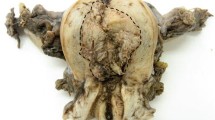Summary
The patient was a 57-year-old woman with ovarian serous cystadenocarcinoma in FIGO clinical stage IV. Cancer antigen 125 (CA 125), tissue polypeptide antigen (TPA) and carcinoembryonic antigen (CEA) were immunohistochemically demonstrated in tumor cells, and the variations of serum CA125 and TPA levels reflected the clinical course. The tumor tissue obtained at exploratory laparotomy was minced with scissors, and transplanted subcutaneously into female nude mice for in vivo maintenance. The tumor cells from 5th generation nude mice were dispersed in Eagle's minimal essential medium supplemented with 10% fetal calf serum, and incubated in Falcon tissue culture dishes at 37°C in 5% CO2 in air for in vitro maintenance. The results were as follows: Histopathologically the tumor transplanted into nude mice showed a cystadenocarcinoma, which closely resembled the original human tumor. Immunohistochemically CA125, TPA and CEA were demonstrated in the tumor transplanted into nude mice as well as in the original human tumor. From the growth curve in nude mice, the doubling time was estimated to be about 3.5 days. Serum TPA levels in nude mice were increased in proportion to the tumor growth after transplantation, but serum levels CA125 and CEA were normal. The concentrations of CA125 and TPA were increased in the conditioned media compared with the control media, although the elevated values were decreased with subsequent passages. CEA concentrations in the conditioned media were unchanged.
Similar content being viewed by others
References
Bast RC, Feeney M jr, Lazarus H, Nadler LM (1981) Reactivity of a monoclonal antibody with human ovarian carcinoma. J Clin Invest 68: 1331–1337
Björklund B, Björklund V (1957) Antigenicity of pooled human malignant and normal tissues by cyto-immunological technique: presence of an insoluble, heat-labile tumor antigen. Int Arch Allergy Appl Immunol 10: 153–184
DiSaia PJ, Morrow M, Kanabus J, Piechal W, Townsend DE (1975) Two new tissue culture lines from ovarian cancer. Gynecol Oncol 3: 215–219
Freedman RS, Pihl E, Kusyk C, Gallager HS, Rutledge F (1978) Characterization of an ovarian carcinoma cell line. Cancer 42: 2352–2359
Fukazawa I, Inaba N, Ota Y, Sato N, Shirotake S, Iwasawa H, Sato T, Takamizawa H, Wiklund B (1987) Serum levels of six tumor markers in patients with benign and malignant gynecological disease. Arch Gynecol 243: 61–68
Fukazawa I, Inaba N, Ota Y, Sato N, Shirotake S, Iwasawa H, Sato T, Takamizawa H, Wiklund B (1987) Relation between serum levels of tissue polypeptide antigen (TPA) and cancer antigen 125 (CA125) and their immunohistochemical identification in benign and malignant gynecological disease. Arch Gynecol 243: 41–50
Gey GO, Coffman WD, Kubicek MT (1952) Tissue culture studies of the proliferative capacity of cervical carcinoma and normal epithelium. Cancer Res 12: 264–265
Hsu SM, Raine L, Fanger H (1981) The use of avidin-biotinperoxidase complex (ABC) in immunoperoxidase technique—a comparison between ABC and unlabeled antibody (PAP) procedures. J Histochem Cytochem 29: 577–580
Inaba N, Ishige H, Ijichi M, Sato N, Okawa R, Sekiya S, Shirotake S, Takamizawa H, Renk T, Bohn H (1982) Immunohistochemical detection of pregnancy-specific protein (SP1) and placenta-specific tissue proteins (PP5, PP10, PP11, and PP12) in ovarian adenocarcinomas. Oncodev Biol Med 3: 379–389
Kawabata M (1984) New establishment and characterization of a carcinoembryonic antigen (CEA)-producing cell line from a human carcinoma of the uterine cervix. Acta. Obstet Gynaecol Jpn 36: 2619–2628
Kidera Y, Yoshimura T, Ohkuma Y, Iwasaka T, Sugimori H (1985) Establishment and characterization of cell line derived from mucinous cystadenocarcinoma of human ovary. Acta Obstet Gynaecol Jpn 37: 1820–1824
Motoyama T (1981) Biological characterization including sensitivity to Mitomycin C of cultured human ovarian cancers. Acta Obstet Gynaecol Jpn 33: 1197–1204
Uehara S, Soh K, Hoshiai H, Yajima A, Suzuki M (1983) Establishment and characterization of human ovarian endometrioid carcinoma cell line. Acta Obstet Gynaecol Jpn 35: 19–26
Woods LK, Morgan RT, Quinn LA, Moore GE, Semple TU, Stedman KE (1979) Comparison of four new cell lines from patients with adenocarcinoma of the ovary. Cancer Res 39: 4449–4459
Yamada T (1974) The cellular biology of a newly established cell line of human ovarian adenocarcinoma in vitro. Keio J Med 23: 53–70
Author information
Authors and Affiliations
Rights and permissions
About this article
Cite this article
Fukazawa, I., Inaba, N., Ota, Y. et al. Experiments with tissue cultures from a human ovarian serous cystadenocarcinoma producing cancer antigen 125 (CA125), tissue polypeptide antigen (TPA) and carcinoembryonic antigen (CEA). Arch Gynecol Obstet 243, 69–81 (1988). https://doi.org/10.1007/BF00932972
Issue Date:
DOI: https://doi.org/10.1007/BF00932972




